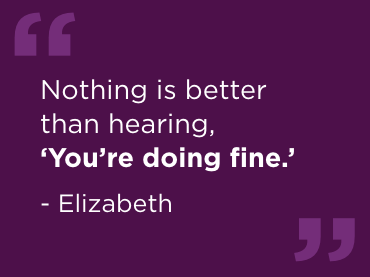The Challenge
In 2000, Elizabeth, 51, a dental hygienist and mother of three grown children, began to have severe headaches that would wake her up at night.
"I knew something was very wrong," she remembers. "I never get headaches."
Her doctor immediately ordered an MRI, and his suspicion was confirmed: Elizabeth had a craniopharyngioma, an aggressive tumor that grows at the base of the skull near the pituitary gland. Although benign, these tumors grow close to critical brain structures, including the optic chiasm, and can lead to blindness and other neurological complications if uncontrolled.
Schedule an Appointment or Ask a Question
Elizabeth underwent a craniotomy, the traditional surgical approach for skull base tumors. Although much of the tumor was removed, the surgery left her with devastating neurological impairments.
"I couldn't lift my head off my shoulder. I couldn't speak or walk, and needed a wheelchair," she says.
After the craniotomy, Elizabeth faced several months of rehabilitation in order to learn to walk, talk, and hold her head up again.
The Path to UPMC
In 2003, she had Gamma Knife® radiosurgery to control the tumor's regrowth. When the tumor grew back for the third time, in 2007, Elizabeth happened to see a television clip that showed a way to remove brain tumors through the nose using the Endoscopic Endonasal Approach (EEA). After consulting with her doctor, she contacted the neurosurgeons at UPMC, who felt that this direct approach to the tumor would give them the best view of the surrounding structures, as well as the best opportunity to remove as much of the tumor as possible. In addition, this approach would minimize trauma to Elizabeth's brain.
The Solution
Elizabeth had EEA surgery in early 2008, and her recovery period, unlike her previous experience, was much easier.
"EEA was the safest, least invasive, least dangerous technique out there, with the least amount of recovery time," she explains. "It was truly amazing. There was not an ounce of pain. I couldn't be happier with the outcome."
The Results
Nine months have gone by since Elizabeth's EEA surgery, and her doctors say her MRI is stable.
"Nothing is better than hearing, 'You're doing fine. We can just watch you now,'" she says.
Although Elizabeth can no longer work as a dental hygienist because she lost some of her manual dexterity after the craniotomy, she enjoys her new job at a women's clothing store. Her peripheral vision has also been lost since the initial treatment, and she no longer drives.
"But without this surgery, no doubt, I would be blind," she says.
Her advice for others?
"Do your homework. Get to the best doctors and techniques first." She adds, "This has been a miracle. I can't say enough about the doctors and the staff. UPMC is doing wonderful things."
Our patient stories profile a number of patients who have had minimally invasive brain surgery at UPMC. Although everyone's care experience is unique, we hope that sharing these stories will help other prospective patients and their families better understand these procedures and their potential benefits.
Elizabeth's treatment and results may not be representative of all similar cases.

















